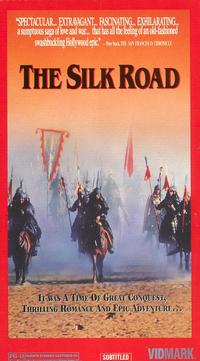fiction.wikisort.org - Movie
The Silk Road (Japanese: 敦煌, Hepburn: Tonkō), also known as Dun-Huang, is a 1988 Japanese film directed by Junya Satō. The movie was adapted from the 1959 novel Tun-Huang by Yasushi Inoue. The backdrop of the plotline is the Mogao Caves, a Buddhist manuscript trove in Dunhuang, Western China, located along the Silk Road during the Song dynasty in the 11th century.
| The Silk Road | |
|---|---|
 | |
| Directed by | Junya Satō[1] |
| Written by | Junya Satō Takeshi Yoshida |
| Based on | Tun-Huang by Yasushi Inoue |
| Produced by | Kazuo Haruna Atsushi Takeda Yoshihiro Yûki |
| Starring | Toshiyuki Nishida |
| Cinematography | Akira Shiizuka |
| Edited by | Akira Suzuki |
| Music by | Masaru Satō |
| Distributed by | Toho |
Release date | June 25, 1988 |
Running time | 143 minutes |
| Country | Japan |
| Language | Japanese |
| Box office | ¥8.2 billion (Japan) $123,959 (USA) |
The film was released in Japan and China on June 25, 1988.[2] It was chosen as Best Film at the Japan Academy Prize ceremony.[3] It is one of the highest-grossing Japanese films of all time.
Cast
- Toshiyuki Nishida as Zhu Wangli, a commander of the Xi Xia empire
- Kōichi Satō as Zhao Xingde, a student of Zhu Wangli
- Anna Nakagawa as Tsurpia, a princess of a Uyghur kingdom
- Tsunehiko Watase as Li Yuanhao, the Xi Xia emperor
- Takahiro Tamura as Tsao Yanhui
Reception
The Silk Road was the number one Japanese film on the domestic market in 1988, earning ¥4.5 billion in distribution income that year.[4] It was the third highest-grossing Japanese film up until then, after Antarctica and The Adventures of Milo and Otis, and remains one of the highest-grossing Japanese films.[5] As of 2013[update], the film has grossed a total of ¥8.2 billion in Japan.[6] In the United States, it grossed $123,959.[7]
See also
- List of historical drama films of Asia
References
- Infobox data from 敦煌 (in Japanese). Japanese Movie Database. Retrieved 2009-05-12. and Dun-Huang (1988) at IMDb
- "敦煌". Maoyan (in Chinese). Retrieved 7 May 2020.
- "Awards for Dun-Huang (1988)" (in Japanese). Internet Movie Database. Retrieved 2009-05-05.
- "Kako haikyū shūnyū jōi sakuhin 1988-nen" (in Japanese). Motion Picture Producers Association of Japan. Retrieved 5 February 2011.
- "邦画興行収入ランキング". SF MOVIE DataBank (in Japanese). General Works. 2008. Retrieved 19 February 2019.
- "歴代ランキング" [All-time box office top 100]. CINEMAランキング通信. Kogyo Tsushinka. Archived from the original on 2013-01-15. Retrieved 23 May 2020.
- "«Шелковый путь» (Tonkô, 1988)". Kinopoisk (in Russian). Retrieved 20 March 2022.
Bibliography
- 敦煌 (in Japanese). Japanese Movie Database. Retrieved 2009-05-12.
- "TON KO". Complete Index to World Film. Retrieved 2009-05-12.
- 敦煌 (in Japanese). walkerplus.com. Retrieved 2009-05-12.
- 敦煌(1988) (in Japanese). allcinema.net. Retrieved 2009-05-08.
- 敦煌 (in Japanese). Variety Japan. Retrieved 2009-05-12.
External links
- Tonkô at IMDb
- The Silk Road at AllMovie
На других языках
- [en] The Silk Road (film)
[ru] Дуньхуан (фильм)
«Дуньхуан» (яп. 敦煌 тонко:, другое название — «Шёлковый путь»[комм. 1]) — совместный японо-китайский фильм 1988 года, поставленный режиссёром Дзюнъей Сато. Эпический исторический фильм-драма, снятый по одноимённому роману Ясуси Иноуэ, написанному в 1959 году. Действие происходит в Китае времён династии Сун. Вымышленная история о молодом учёном, пустившемся в путешествие по шёлковому пути в поисках знаний и попавшем в водоворот военных действий, пройдя через множество различных жизненных испытаний, он, в конечном счете, спрячет для истории ценнейшие артефакты, найдя таким способом, как оставить памятник своей жизни и любви[комм. 2].Другой контент может иметь иную лицензию. Перед использованием материалов сайта WikiSort.org внимательно изучите правила лицензирования конкретных элементов наполнения сайта.
WikiSort.org - проект по пересортировке и дополнению контента Википедии